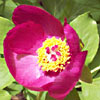Coral peony is a beautiful plant, very rare in Israel, attracting many plant enthusiasts during its blooming season. It is a perennial, branched, glabrous forb usually 40 cm high but may rich twice that size. The large leaves are dark green, split into three broad lobes, each of which is split into 3 lobes again. This may have given it its Arabic name which means bear’s paw. The leaves grow out of the ground rolled like a spear having a reddish color. Its tuberous roots grow deep into the ground.
Peonies are primitive dicots closely related to the Ranunculaceae. In Israel it is protected by law and considered an endangered species since it grows in a small area. Some botanists consider the Israeli population a distinct species.
The genus scientific name Paeonia was derived from the name of Paean which was the name of the physician of gods in eth Greek mythology. Peony seeds soaked in wine were considered a remedy for nightmares, bad spirits, neural disorders, epilepsy, migraines and liver problems among other things.
Coral peony blooms in late spring, April-May, but the exact flowering date vary from year to year. The color of the large, 10 cm, bowl-shaped flowers can be deep pink to crimson. It has 3 – 5 sepals and 5 – 8 petals. Sometimes there are sepal-petal intermediates such as sepals with pink stripes. Both sepals and petals are concave. The large number of stamens with pink filaments and sulfur-yellow anthers enhance to the beauty of the flowers. The pistils a downy white with red stigmata. The flowers are pollinated by large bees (Bombus and carpenter bees). The star shaped fruit has 3 – 5 lobes that open when ripe to expose the red inside with red seeds in white wool. Later the seeds color turns to shiny dark blue. Some consider the red seeds to be infertile which act as attractants for birds that will disperse the seeds.
Coral peonies reproduce vegetatively as well. The species is variables and some plants may look somewhat different from the above description.
Coral peony grows in Israel in a small area at the upper basin of the Kziv stream in the Meiron mountain. Its preferred habitat is deep humic soil in the forest, mostly in the northern slopes of Mt. Hillel. Not all the plants bloom every year.
Paeonia is the only species in its family Paeoniaceae There are 50 species in this genus in Asia, Europe and Western North America. Paeonia mascula is known from a wide area from Morocco to Iran and the Israeli population is the most southern population of this species.
Many species and cultivars of peonies are used in gardening and the cut-flower industry in Asia, Europe and Western North America. In China and Japan, they have been cultivated for more than a thousand years, and in Europe since the Middle Ages.
Written by Mike Livneh






